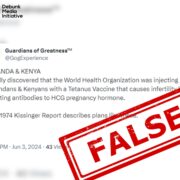Fact Check: CO2’s Impact on African Rainfall

“If CO2 was powerful enough to cause too much rain in Africa, why was it not powerful enough to prevent too little rain in Africa?” With a hashtag saying climate is a scam, a tweet shared with us asked
Carbon dioxide (CO2) is a greenhouse gas, which means that it traps heat in the atmosphere. This can lead to global warming. However, carbon dioxide is also essential for life on Earth, according to Science Direct, a database of scientific and medical publications.
According to Oxford University, a research paper published in Nature Climate Change shows that CO2 can have both positive and negative impacts on rainfall, depending on the region and other factors. While it can contribute to more intense rainfall in some areas, it can also lead to decreased rainfall in others. Therefore, while CO2 is a powerful driver of climate change, it is not powerful enough to be the sole determinant of rain patterns in Africa
Each region is impacted differently by increased CO2. In some regions of Africa, including the Horn of Africa, it has been discovered that CO2 emissions are linked to less rainfall while other regions have extreme rainfall, according to data presented in the IPCC’s Sixth Assessment Report.
Numerous changes in precipitation patterns, including more frequent and intense extreme rainfall events, longer dry spells, and more frequent droughts, have all been linked to climate change in Africa. However, these changes cannot be attributed solely to CO2, as they are influenced by a complex interplay of factors, including ocean and atmospheric circulation patterns, land use changes, and natural climate variability, according to the United Nations Climate Change.
Verdict
Therefore, the claim that if CO2 was powerful enough to cause too much rain in Africa, it should also be powerful enough to prevent too little rain in Africa is misleading. CO2 is one of many factors that can influence precipitation patterns, but it is not a direct cause of too much or too little rain in any particular region.
The claim is misleading because it is based on a misunderstanding of the role of carbon dioxide (CO2) in the climate system. CO2 is a greenhouse gas that traps heat in the Earth’s atmosphere, causing the planet to warm. This warming can lead to changes in precipitation patterns, including both too much and too little rain, depending on the location and other factors.
This fact-check was produced by the Debunk Media Initiative with support from Code for Africa’s PesaCheck, the International Fact-Checking Network, and the African Fact-Checking Alliance network.
2021 Africa Check Award-winning Fact-Checker, Media Challenge Initiative Fellow class of 2020, 2022 Code For Africa and International Fact-Checking Network Climate Change Fact-Checking Fellow, 360 Digital Sherlock, trained by the Atlantic Council’s Digital Forensic Research Lab in open-source intelligence.







